|

VENICE CURIOSITIES
There are many curiosities about Venice. In other pages of the website
we have already shown some, but in this section we will try to list other
interesting curiosities.
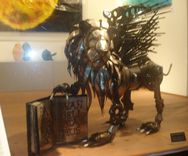
Curiosities 1/16: The symbol of Venice is the winged lion with a book
open under a paw. The inscription in Latin written on the book is as
follows: "Pax tibi Marce Evangelista Meus", and it means "Peace to you Mark
my evangelist". If the winged lion was represented in paintings or sculptures
with a sword it meant that Venice was facing a period of war.
Most of the "lions" were destroyed by Napoleonic troops in 1797, what we see
now are almost all faithful copies of the originals. Even today in
St. Mark's Square are visible 13 "lions".
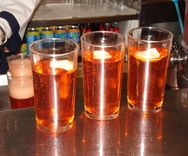
Curiosities 2/16: In Venice the most popular
alcoholic beverage is called "Spritz": it's
comprised of one part of white wine, one part of mineral water (carbonated),
and a third part of moderated alcoholic liqueur (sweet or bitter). Also a
lemon rind and/or an olive should be added. For those not accustomed to this
drink even a glass can go to one's head. The origin of the name of this
alcoholic drink comes from the age of Austrian dominion in Venice, the verb in
German language "spritzen" means "to sprinkle". Actually this alcoholic beverage is
well known in the entire Veneto region but the Spritz has been created
specifically in Venice. Up until the 1980's it was hard to find the drink
outside of province borderline (believe us!). The easiest places to find
this drink are Santa Margherita Square and San Giacometto Square (near the
Rialto Bridge), where there are many bars attended mostly by young people.
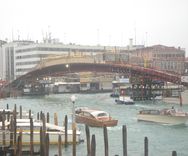 Curiosities 3/16: In Venice are still visible 417 bridges, of which 72 are private.
Among them 300 bridges are made by stone, 60 made by iron, the other 57 made by wood.
The last bridge built in the City is the one designed by Spanish architect Santiago Calatrava (the Constitution Bridge,
installed in August 2007 and open on the 11th of September 2008).
This is the fourth bridge crossing the Grand Canal
that links Piazzale Roma car parking with Santa Lucia train station. In ancient
times the bridges had no steps and until the sixteenth century it was permitted
to ride horses in Venice. There are only two bridges without railings (spallette).
The first one is located in
Torcello and is called Ponte del Diavolo (the Devil's
Bridge), and the second one is private and is located in Rio di San Felice (near
the Scuola Grande della Misericordia).
Curiosities 3/16: In Venice are still visible 417 bridges, of which 72 are private.
Among them 300 bridges are made by stone, 60 made by iron, the other 57 made by wood.
The last bridge built in the City is the one designed by Spanish architect Santiago Calatrava (the Constitution Bridge,
installed in August 2007 and open on the 11th of September 2008).
This is the fourth bridge crossing the Grand Canal
that links Piazzale Roma car parking with Santa Lucia train station. In ancient
times the bridges had no steps and until the sixteenth century it was permitted
to ride horses in Venice. There are only two bridges without railings (spallette).
The first one is located in
Torcello and is called Ponte del Diavolo (the Devil's
Bridge), and the second one is private and is located in Rio di San Felice (near
the Scuola Grande della Misericordia).
Curiosities 4/16: In ancient times Venice was broken up into 2 factions: the
"Castellani" and the "Nicolotti".
The first faction lived in the eastern part
of Venice (an industrial area with the Arsenale), while the second one was
settled in the west zone in which is located San Nicolò dei Mendicoli Church
(they were fishermen). Those two groups were always rival factions and they
began to fight in the fourteenth century, from September throughout Christmas,
in the so called "Fist Wars". These battles were quite bloody and were fought
on top of some of the Venice bridges as "dei Carmini", "di Santa Fosca", "della
Guerra" and just "dei Pugni". These fights could be of three kinds: a single
boxing match (la Mostra), a multiple fight (la Frota), and the battle to conquer
the bridge (Guerra Ordinata). During that time period there weren't railing along
the bridges and as a result often the fighters fell into the water. The "Fist Wars"
caused many serious wounds and, more rarely, some deaths. Growing animosity towards
these fights caused them to be banned in 1705. Those fights were replaced, during
Carnival, by the "Forze d'Ercole". It was a game based on balance, (every team
supports their teammates on shoulders), in which the goal was to "build" the highest
human pyramid.
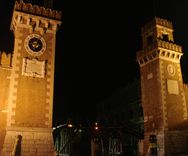
Curiosities 5/16: The Arsenale of Venice has a surface of more than 320,000 square
meters (about a fifth of the whole city). It was visited by the celebrated Italian
poet Dante Alighieri (1321). At the age of its best development in the Arsenale
there were 18.000 ship-yard workers, the "Arsenalotti". From this shipyard was
launched the majority of the navy commanded by Sebastiano Venier that fought and
defeated the Turkish in Lèpanto (on the 7th of October 1751).
Curiosities 6/16: There are five bells located on top of St. Mark's Bell Tower: the
"Maleficio" announced the death penalties in Piazzetta; the "Marangona" gave the
opening and close hours to the carpenters (or "marangoni") of the Arsenale; the
"Mezzana" struck at noon; the "Pregadi" announced to the senators that the hour
of their reunions were started; the "Trottera" invited the nobles to trot their
horses in order to get in time to the convocations in Doge's Palace. The "Marangona",
the biggest bell, was the only bell not destroyed by the St.Mark's Bell Tower collapse.
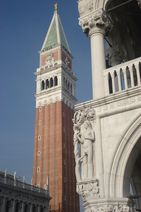
Curiosities 7/16: St. Mark's Bell Tower is 98.6 meters high. On top is located a golden
angel, its turning wings show the direction of the wind at that altitude. The Bell
Tower collapsed on the 14th of July 1902, (luckily there were no victims). It was
rebuilt in the same place in less than 10 years and unveiled on the 25th of April
1912, St.Mark's Day (the city patron). The admittance to the Bell Tower, from which
is possible to see an incomparable view of Venice, is allowed only by elevator.
Curiosities 8/16: The most common family name in Venice is Vianello. It takes 4 pages
in the telephone book. It's followed by the family name Scarpa (3 pages). The typical
family name of Burano is Dei Rossi.
In Murano it is Toso, while the most popular in
Chioggia and Sottomarina are Boscolo and Tiozzo. The most common nicknames in the City
are Bepi (Giuseppe), Tony (Antonio) and Nane (Giovanni). The most common first names
in Venice are Marco, Alvise, Niccolò and Jacopo.
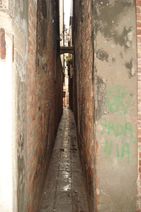
Curiosities 9/16: The most narrow alley in the City is Calletta Varisco. It's located
near San Canciano Square: it has a width of only 53 centimeters (about 21 inches)!
Curiosities 10/16: Elena Lucrezia Cornaro Piscopia was the first woman in the world to get
a university degree (on the 25th June of 1678). Elena was born in Venice in 1646. A
plaque is located on side of Loredan Palace (the seat of the City Hall, with
Ca' Farsetti).
Curiosities 11/16: Currency in Venice is called "schei". This nickname comes from a coin
used during the Austrian dominion, it has the inscription "Scheidenmunze" and the
Venetians shortened the name for convenience.
Curiosities 12/16: The first edition of
Venice Biennale was in 1895. The first year of
Venice International Film Festival was in 1932. This event takes place every year at
Lido di Venezia with the support of Biennale Cinema.
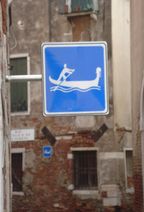
Curiosities 13/16: The traffic in Venice is regulated like in the mainland by specific
road signs (one-way only, no thoroughfare, etc.). The unique real traffic-light in
Venice is located in a canal called Rio Novo, however it's actually out of order. All
of the motorboats must hold the right side, except in the Rio Novo, in which, a unique
case in the city, it's obligatory driving on the left side of the canal. Rowing boats
must hold the left side as the rower is located on the right side of the boat and it
must always have the ability to row.
Curiosities 14/16: A tornado in Venice? Unluckily in Venice there was a terrible
tornado near Sant'Elena Island on 11 September 1970. It caused enormous damage, including the
sinking of a vaporetto and the deaths of 21 people.
Curiosities 15/16: The word ciao has
Venetian origins. In ancient times Venice people were
accustomed to greet in this way: "s-ciavo vostro", it
means "I'm your servant, your slave" (in Italian, "schiavo").
This is the pronounciation: s-ch-e-aa-v-o. So time after
time it became "s-ciao" and finally "ciao".
Curiosities 16/16: The squares in Venice are called "Campi" (campo means
field in Italian), in fact formerly were used as vegetable fields.
The fields in front of the churches were often used as cemeteries.
Later in every field was built a well, which could draw rainwater
filtered by layers of clay.
You can find more curiosities in this
blog on Venice.
Budget hotel in Venice
|